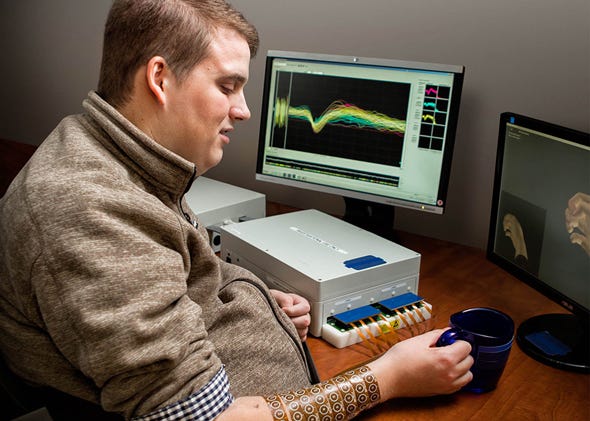April 14, 2016
Researchers in Ohio have enabled a paralyzed young man to once again move his wrist and hand--and complete tasks such as strumming a guitar and swiping a credit card--all through a chip implanted in his brain.
Nancy Crotti
|
Ian Burkhart can grasp a coffee mug, too. (Image courtesy of Ohio State University) |
Back in 2014, a paralyzed young man moved his hand for the first time in four years just by thinking about it, thanks to a chip implanted in his brain. Now he can play guitar and perform five other wrist and hand motions.
Researchers at Ohio State University and the nonprofit research organization Battelle announced the advance in an articlepublished in the journal Nature. They applied machine-learning algorithms to decode Ian Burkhart's neuron activity, and controlled activation of his forearm muscles using a custom-built, high-resolution neuromuscular electrical stimulation system. In effect, they bypassed the injured area of Burkhart's brain so he could once again grasp, manipulate, and release objects, the Nature article says.
"This is the first demonstration to our knowledge of successful control of muscle activation using intracortically recorded signals in a paralysed human," the article continues. "These results have significant implications in advancing neuroprosthetic technology for people worldwide living with the effects of paralysis."
The chip--which measures 0.15 in. across and is outfitted with 96 electrodes--was implanted inside the region of Burkhart's brain that controls hand movement, according to Ohio State. The system delivered electrical stimulation to Burkhart's right forearm via a custom-made, flexible sleeve embedded with 130 electrodes. A stereo camera tracked and recorded his hand movements from above. Burkhart, 24, practiced concentrating his thoughts into moving his arm three times a week for 15 months in front of a computer monitor, the article said.
He was also able to pour liquid from a bottle into a jar and stir the liquid while holding a stick, and play a guitar video game. Burkart was injured in a freak swimming accident when he was a college freshman. Paralyzed from the neck down, he still has some movement in his shoulder and elbow, the article said.
"It's crazy because I had lost sensation in my hands, and I had to watch my hand to know whether I was squeezing or extending the fingers," Burkhart, now a business student, told the New York Times.
The chip is connected to a port in the skull via a wire, and then the cable delivers the information to a computer that uses an algorithm to translate the signals so that they can then be transmitted to the electrode sleeve.Although patients would need to be connected this way, the researchers believe their work could mean more independence for people living with paralysis. Their system can transmit more information from the brain than existing neurostimulation systems that use EEG or EMG, the Nature article says.
"To allow transfer of this work to other patients, further improvements will be required on the microelectrode technology, algorithms, and (neuromuscular electrical stimulator)," it concludes. "'However, the electronic neural bypass presented here demonstrates what is possible in the future and can offer hope for movement restoration to people living with paralysis worldwide."
Learn more about cutting-edge medical devices at MD&M East/a>, June 14-15, 2016 in New York City. |
Nancy Crotti is a contributor to Qmed and MPMN.
Like what you're reading? Subscribe to our daily e-newsletter.
About the Author(s)
You May Also Like



